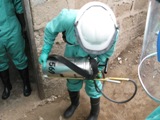
 |
| News & Outreach |
|
||||||
Global Health MattersJanuary - February, 2008 | Volume 7, Issue 1
DDT's Ongoing Role in Malaria Control ExaminedWhile abandoned by the Americas and Europe because of known environmental toxicity, the WHO considers indoor spraying of DDT a best practice for malaria vector control in much of the world. One study included in the supplement examines the controversy surrounding DDT, the effectiveness of indoor residual spraying (IRS) with the pesticide, a cost-benefit analysis and a survey of its use by different malarial countries. By treating dwellings with DDT, mosquitoes are not only killed by coming in contact with sprayed surfaces, but are greatly deterred from entering the homes at all. When used in combination with pyrethroid-treated bed nets, it can reduce malaria transmission better than bed nets alone, according to the study.  DDT is also the least expensive insecticide available, costing only about $1.60 per house and providing about six months of effectiveness. The authors contend that DDT does have a place in malaria control programs but should be carefully monitored for negative ecological, economic, or health effects. Dichlorodiphenyltrichloroethane (DDT) for Indoor Residual Spraying in Africa: How can it be used for Malaria Control? Sadasivaiah S, Tozan Y, Breman JG. Am J Trop Med Hyg. 2007; 77 (Suppl 6): 249-263. To access the paper visit: http://www.ajtmh.org/cgi/content/full/77/6_Suppl/249 Should you require Adobe Acrobat for viewing PDFs, current and free accessible plug-ins are available at the Adobe website.
|
|||||||
|